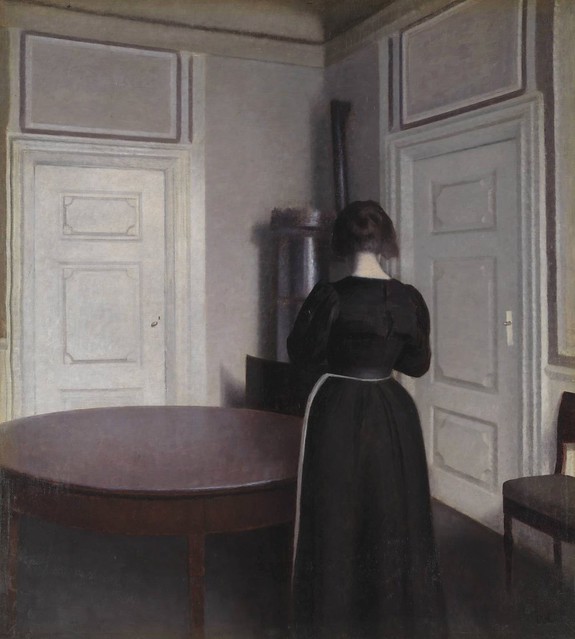'Manet to Picasso: A Redisplay of Modern Masters from the National Gallery Collection' from 22 September 2006, to 23 May 2007 at the National Gallerry London, offered visitors a unique opportunity to re-examine the National Gallery's permanent collection, learning more about well-known works such as Seurat's 'Bathers at Asnières and Van Gogh's 'Sunflowers', as well as the opportunity to enjoy many works generously lent to the display by private collectors.

Camille Pissarro, The Boulevard Montmartre at Night, 1897 © The National Gallery, London.
The six rooms of Manet to Picasso were organised broadly chronologically allowing National Gallery visitors to trace the dramatic changes that occurred during some of the most exciting years of European artistic development.
'Painting Modern Life' was the subject of the first room. It offered the opportunity to view side by side

the recently acquired painting by Adolph Menzel, 'Afternoon in the Tuileries Gardens' (the first painting by this German artist to enter a UK collection),

with its inspiration, Manet's 'Music in the Tuileries Gardens'.
There was also a chance to explore Manet's working methods thanks to the loan of his 'Study for Music in the Tuileries Gardens' (Private Collection).
Room 2 focused on the work of one of the founding fathers of Impressionism, Claude Monet. Spanning a 50-year period, iconic works such as

'Bathers at La Grenouillère' and

'The Water-Lily Pond'
hung alongside loans including
'The Japanese Bridge' and '

The Grand Canal, Venice' (both Private Collection).
Impressionism was also the theme of the third room, which features several works by Renoir, alongside whom Monet often painted, including his celebrated

'The Umbrellas' and

'Boating on the Seine'.
Two pairs of artists whose desire was to create art beyond the Impressionist techniques are featured in the fourth room.
Seurat developed 'pointillism', a technique he began to develop on a massive scale in
https://gluwhite-platinum.blogspot.com/
https://gluwhite2022.blogspot.com/
https://vien-sui-trang-da-gluwhite.blogspot.com/
https://vien-sui-gluwhite.blogspot.com/
'Bathers at Asnières'
while Pissarro also experimented with this style ('Père Melon sawing Wood, Pontoise' - Private Collection).
Both Van Gogh and Cézanne rejected Impressionist techniques in their works such as

'Van Gogh's Chair' and

'Avenue at Chantilly',
respectively.
Images of dancers, women at their toilette and portraits from across Degas's career were shown in room 5. Now, in one space, it was possible to appreciate why he is acclaimed as a master of many techniques. Degas used various media (oils, pastel, charcoal and pencil) in works including
'After the Bath, Woman Drying Herself' and

'Beach Scene'.
He also used the new skill of photography to help create his compositions.
The final room of Manet to Picasso examined how the changing current of artistic ideas spread across the continent - in France

(Toulouse Lautrec, 'Woman Seated in a Garden'),

through Spanish artist Picasso ('Child with a Dove'),

on to Denmark (Hammershøi, 'Interior', Tate, London) and

Finland (Gallen-Kallela, 'Lake Keitele').
Camille Pissarro, The Boulevard Montmartre at Night, 1897 © The National Gallery, London.
The six rooms of Manet to Picasso were organised broadly chronologically allowing National Gallery visitors to trace the dramatic changes that occurred during some of the most exciting years of European artistic development.
'Painting Modern Life' was the subject of the first room. It offered the opportunity to view side by side
the recently acquired painting by Adolph Menzel, 'Afternoon in the Tuileries Gardens' (the first painting by this German artist to enter a UK collection),
with its inspiration, Manet's 'Music in the Tuileries Gardens'.
There was also a chance to explore Manet's working methods thanks to the loan of his 'Study for Music in the Tuileries Gardens' (Private Collection).
Room 2 focused on the work of one of the founding fathers of Impressionism, Claude Monet. Spanning a 50-year period, iconic works such as
'Bathers at La Grenouillère' and
'The Water-Lily Pond'
hung alongside loans including
'The Japanese Bridge' and '
The Grand Canal, Venice' (both Private Collection).
Impressionism was also the theme of the third room, which features several works by Renoir, alongside whom Monet often painted, including his celebrated
'The Umbrellas' and
'Boating on the Seine'.
Two pairs of artists whose desire was to create art beyond the Impressionist techniques are featured in the fourth room.
Seurat developed 'pointillism', a technique he began to develop on a massive scale in
https://gluwhite-platinum.blogspot.com/
https://gluwhite2022.blogspot.com/
https://vien-sui-trang-da-gluwhite.blogspot.com/
https://vien-sui-gluwhite.blogspot.com/
'Bathers at Asnières'
while Pissarro also experimented with this style ('Père Melon sawing Wood, Pontoise' - Private Collection).
Both Van Gogh and Cézanne rejected Impressionist techniques in their works such as
'Van Gogh's Chair' and
'Avenue at Chantilly',
respectively.
Images of dancers, women at their toilette and portraits from across Degas's career were shown in room 5. Now, in one space, it was possible to appreciate why he is acclaimed as a master of many techniques. Degas used various media (oils, pastel, charcoal and pencil) in works including
'After the Bath, Woman Drying Herself' and
'Beach Scene'.
He also used the new skill of photography to help create his compositions.
The final room of Manet to Picasso examined how the changing current of artistic ideas spread across the continent - in France
(Toulouse Lautrec, 'Woman Seated in a Garden'),
through Spanish artist Picasso ('Child with a Dove'),

on to Denmark (Hammershøi, 'Interior', Tate, London) and
Finland (Gallen-Kallela, 'Lake Keitele').
Comments
Post a Comment